An easy-to-use software that actually helps you manage your business may seem as unrealistic as Sam Altman’s idea for an eyeball identification orb.
With this many options on the market, especially the unnecessarily overpacked ones, we absolutely understand this conundrum.
In this article, we not only test and analyze two software, setting Tave vs Dubsado, but also give you one more option you may have thought was unattainable — an easy-to-use and functional software.
Let’s get right to it.
Opening Statements: Tave Vs Dubsado
Jurors, this case is about two complex CRMs — Tave and Dubsado. Both famous for their heck of a learning curve, complexity, outdated designs, but also for combining some useful features for business management.
We have tested both solutions and talked about Tave and Dubsado multiple times. But we haven’t put these two directly against each other until now.
Let’s change that.
Who Was Tave Created For?
Tave is a solution that caters specifically to photographers, with a few courtesy nods to that group here and there.
But since the software combines basic features for business management, the niche crevice is not that narrow. Meaning that if you want to combine quotes, invoices, and a client portal with task & lead management, then Tave may fit your non-photography business just as well.
With the many features comes complexity, making Tave a software dedicated to users with a lot of patience and time to get the hang of it.
PS: and if you’re actually looking for the right software for your photography business that truly gives you all the features needed in that niche, make sure to give our Studio Ninja alternatives article a read to learn more about tools like Sprout Studio, ShootProof, or 17Hats.
Who Was Dubsado Created For?
Dubsado is dedicated to small businesses of many different niches, but the creators themselves have a photography origin, so we’re not fully leaving this realm.
The features available are pretty similar to those in Tave. And that’s how in Dubsado you’ll find projects, invoices, task management, email communication, a client portal, and more.
If you want to go for this software, you’ll have to bear with a steep learning curve. Dubsado is not easy to figure out.
The Evidence: Pros & Cons
Based on our experience testing both solutions, we can draw a list of pros and cons for both software to help summarize the reasons to choose each one.
Tave’s Side
When we analyzed Tave for the first time, comparing it to HoneyBook, its deep complexity almost made it too difficult to check this tool off the list.
On the other hand, some features proved to be quite efficient, especially Tave’s workflows that serve mainly as a task management feature.
Let’s take a closer look at the benefits and drawbacks of Tave.
Tave’s Pros
When testing Tave, we especially liked the following things.
The right combination of features: Tave really put a thought into combining a list of features for the software. Running a business doesn’t have to be juggling a dozen tools. With Tave, you can create your invoices, quotes, contracts, email them to clients, connect your Calendar to connect any events, and manage your tasks and leads in one place.
Email communication & scheduling: Tave’s client communication is based on email, as most software tends to do. But even leaving the obvious risks email communication brings, including the constant back-and-forth battles aside, some tools also struggle to keep email communication professional.
In Tave however, this functionality seems to work quite well. The emails come from our email address via Tave, and not from the software only as in some cases. Moreover, there are quite a few templates to use, there’s the option to create our own templates, and the scheduling is also pretty good.
You can choose between four sending options, either immediately after hitting Send, in 5 minutes, at 8 am, or at a specific time you choose.
Jobs have everything you need in one place: the Jobs section in Tave is sort of your projects section. If you click on a specific job, you’ll be met with a clean enough page that showcases everything you need to know about that specific project. At the top, there’s a commonly-seen pipeline with four stages: Lead, Booked, Fulfillment, and Completed. The job moves through the pipeline according to the actions you take within it.
Then you’ll see the overview page that summarizes the job. You’re also free to click between the 9 other tabs that contain more specific information on the project and let you perform additional actions, such as issue a quote, invoice, or schedule an email for the client.
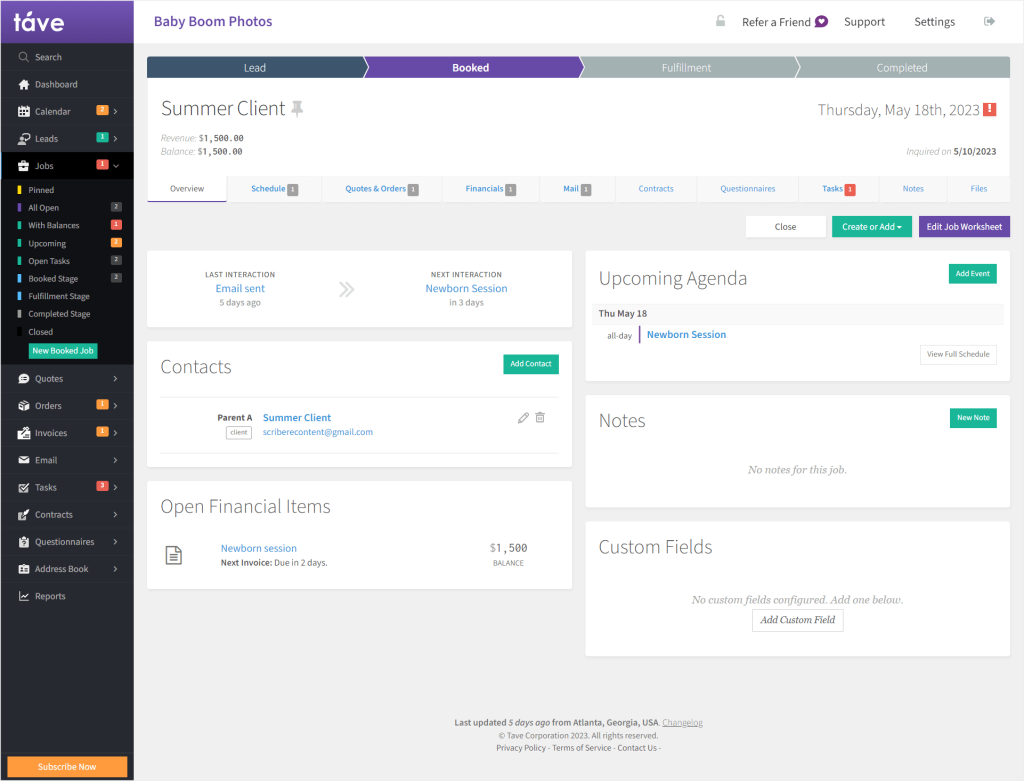
Cool task management, especially for photographers: task management in Tave is hidden under the workflows settings and in the actual task lists.
What’s helpful about this feature, at least for photographers, is that you get two pre-prepared workflows with 12 and 13 tasks respectively catered to photography jobs specifically.
So if you add any photography job, the task list will include the premade by Tave workflows, which may be especially useful for newbie photographers who are still in the process of figuring out their workflows.
If you’re working in a different niche, you can also create your own task list templates in the workflow settings to use for future jobs.
Nice template creation and template saving: the settings in Tave hide a lot, including the already-mentioned templates. And that’s something you should definitely take advantage of when working in Tave to save you some much-needed time and effort on future projects.
You can create templates for workflows, aka task lists, but also contracts, emails, payment schedules, packages, quotes, and more.
Tave’s Cons
Now onto the less pleasant part of our experience with using Tave.
Quantum-physics complicated: the first on our list of Tave’s drawbacks has to be the fact that this software is pretty dang complicated. What contributes to the complexity of the tool the most is the fact that there are a lot of nooks and crannies you have to get into — the never-ending settings, tabs, and options to go through. Plus, performing even the simplest of actions takes a lot of steps and tabs to fill, which ends up being overwhelming.
Especially if you don’t take your time to add in your templates first. In that case, you’ll be met with awkwardly empty fields. To top it all off, even some branding customization in Tave requires using CSS.
Outdated designs: Tave’s look is not the most fresh. And unfortunately, since we last paid a visit to Tave, which was almost a year ago, nothing in that matter changed. Tave is still looking outdated and its left-side panel is still a huge mess. There’s about a billion options, while each option reveals even more suboptions.
You can customize Tave’s panel to your liking in the Sidebar Items settings, but until you take the courage to tackle that, you’ll be left feeling overwhelmed with how it looks and how many options it hides.
The outdated designs of the software do not only affect the ease of use, but ultimately, the experience of your customers as well, since they’re not met with the most modern and professional looking documents and client portal space.
Lack of proper team collaboration: if you’re sick of being a lone wolf in your business or already have a team, Tave may not be the best option to go for. There’s no team communication and no team-sharing space to work on projects together.
Too simple of a client portal: if you want your client portal to be a modern, professional one, don’t count on Tave. The client portal is too simple in terms of its looks and in terms of the functionality. It shows basic documents and allows your clients to update their information. Plus, finding the settings, the actual client portal, and the way to share it with the client is beyond complicated.
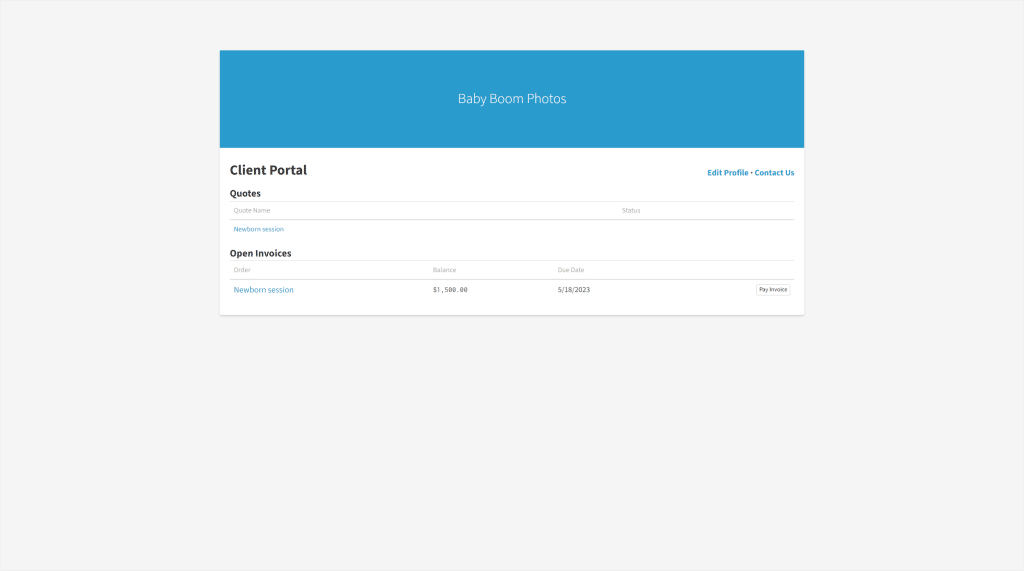
Dubsado’s Side
Dubsado is just as Tave, complicated to use, with a steep learning curve, and combining useful features. But this software, when compared with Tave, may be slightly easier to use.
Dubsado’s Pros
Dubsado comes with the following benefits.
Workflows with automation: We’ve obsessed over Dubsado’s workflows before, and we’re going to do it again. Dubsado knows how to create proper automatic workflows. You can set up your workflows with different triggers, even triggering one workflow to start after another. This definitely helps in automating the repetitive parts of your business.
Scheduler: What Tave lacks, Dubsado provides. An online scheduler is a feature helping your clients book sessions or events with you the easy way. Even though Dubsado’s scheduler is not the best one we’ve seen so far, for example, in HoneyBook, it still gets the job done. You basically set your availability and send it over to the client to pick a time they want to book. So, not completely self-service, still requiring a bit of an effort from you. But Tave doesn’t have any scheduler option, so that’s still a plus for Dubsado.
Drag & drop builder: the documents you create in Tave require you to either paste in the content you want them to have or type it directly in there. Dubsado, on the other hand, gives you a nice drag & drop builder for your documents for an easier set up. Plus, it recently got a refreshed look!
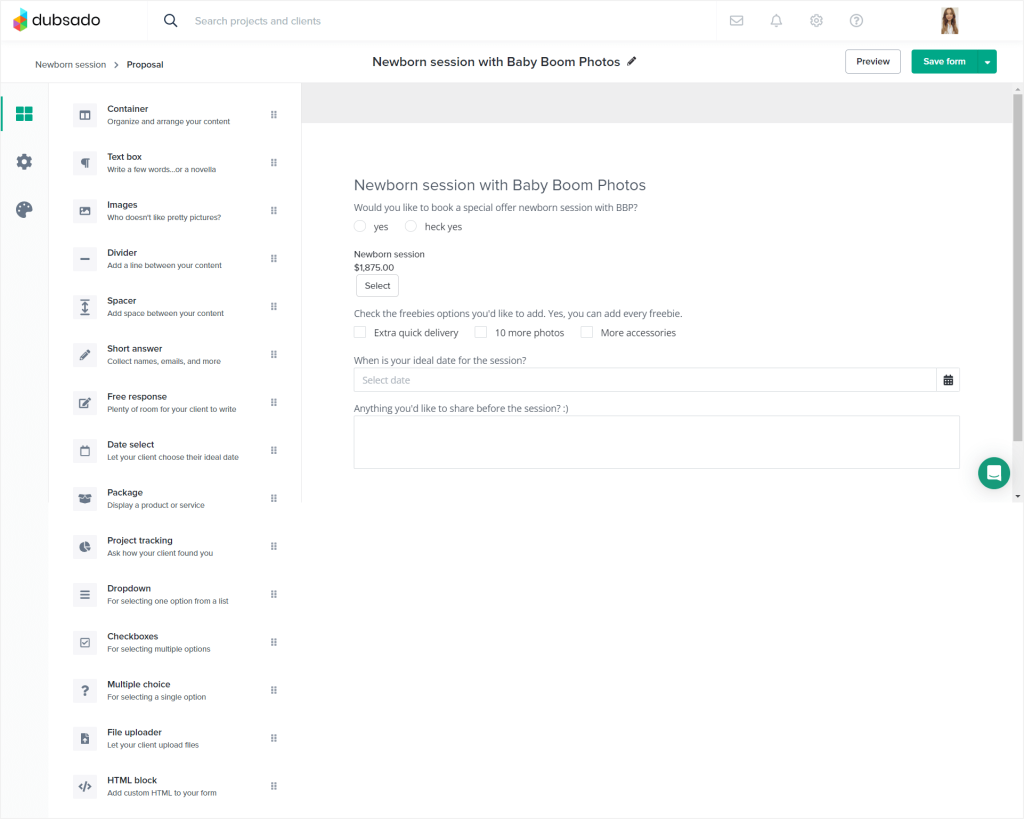
Not-time-limited free trial: Despite the fact that Tave’s free trial lasts 30 days, that’s still not enough to properly test out any software. Dubsado makes up for that with a non-time-limited free trial.
Instead, you’re getting a free trial that’s limited to adding 3 clients.
Dubsado’s Cons
Now onto things that we didn’t love when testing Dubsado.
Complexity & steep learning curve: the complexity issue is one that takes the hit the most when it comes to Dubsado. Again, as it was the case with Tave, there’s just too many options, especially the ones hidden in the settings. So if a steep learning curve is not something you’re prepared for, Dubsado shouldn’t be your number one choice.
Outdated designs: Another flaw of Dubsado lies in its outdated designs. So much that it’s even mentioned by software’s users on Reddit. And as much as you can turn a blind eye to it or get used to it with time, your clients would definitely appreciate a more modern look, fit with the times.
Client communication based on email: even though both software bases its client communication on email, that of Dubsado is a little less efficient. You get three scheduling options: later, which basically means sending the email in three hours, at 9 am, and next week, with no custom time to choose. Sent emails look simple enough, but unfortunately, even though they contain our name, the email goes out from “mail Dubsado”, while the client’s reply goes into our email inbox, ultimately mixing the communication channel.
Client portal confusion: the client portal in Dubsado is a complicated matter. First of all, the settings of this feature are hidden in the general settings of the platform, which in itself is a little confusing. And then to get to the actual client portal of each specific client, we have to scooch over to the Projects section and spy with our little eye the tiny section called Client Portal to activate/deactivate, send, view, or set the password for that client portal. Plus, there’s not much to the client portal itself, because your clients basically get access to their emails, invoices, and forms.
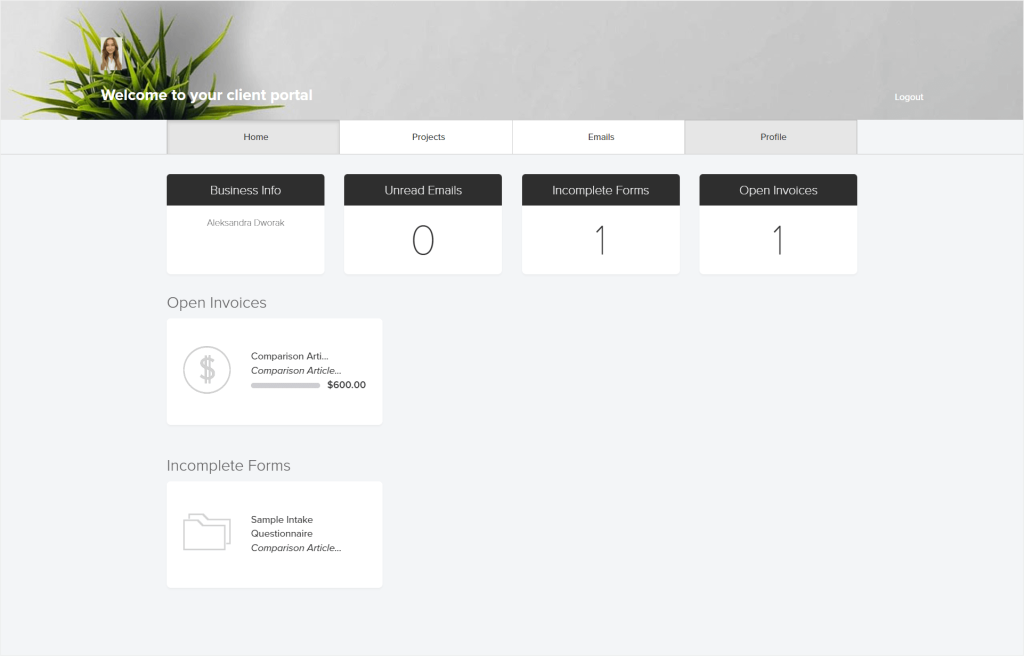
Witness Statements: What’s The Flow?
What’s a review without actually seeing the software in action?
To give you the full picture, we’re going to compare Tave and Dubsado in an example flow — for ordering a newborn session in our imaginative photography business — Baby Boom Photos.
Step One: Creating An Offer
Neither Tave nor Dubsado allow us to create a separate page with our offer for clients to make orders, as seen in some software solutions, like Paperbell or ClientVenue.
That’s why we have to start our journey to sell our fake newborn session elsewhere.
Namely, both Tave and Dubsado make it possible to create package templates.
We’ve first headed to Tave’s settings to find the Templates section, in which we’ve found the packages templates.
Side note: it’s best if you create your Products templates prior to that step, because packages basically consist of products. If you add them to the software first, the package creation will be much easier than creating the products manually.
In Dubsado, the whole process is pretty similar, but the packages creator was not hidden in the settings of the software, but in the Templates section instead. And just as in Tave, we can create our package with specific elements, price them, add discounts, tax, and description.
But it’s worth noting that in Dubsado, there’s no way to create product or service templates, as there is in Tave. The software does remember the services we add when working on our projects, but we can’t create the templates as a rough version otherwise.
So even though the package creator in Tave at first glance looks much more complicated, it worked more efficiently than that of Dubsado. In the latter, we had trouble adding a tax because you have to name them, but you can’t use the same names for the same percentage-value taxes. Meaning that if you add a tax, you can’t reuse it in different packages. Essentially forcing you to add the same tax under a different name. The discount option also froze on us, making it impossible to add it to the package. You can add discounts separately, but why bother with the Apply Discount option on the packages if it’s not working?
Overall, Tave’s package template creation turned out to be more smooth.
Step Two: Share The Offer With The Client
Now that we’ve created our package, we’d probably want our client to see it to decide if that’s something they’d like to buy.
To do that in both software, we have to create a quote/proposal.
Dubsado surprised us with a refreshed proposal builder that basically works the same as the previous one, but the design is much cleaner and modern, which we do appreciate.
We haven’t run into any major problems with adding our proposal and adding the package created earlier to the quote itself.
But we did struggle a little bit with sending the proposal to the client. We’ve figured out that we would most likely need to create a new project to share the proposal with the client, but still, we couldn’t find the Proposal section there. A quick trip to Dubsado’s help center taught us that we have to actually take a peek into the Forms section instead.
Once there, you’ll find two options to share the proposal with the client, either via email or by sharing a link to the proposal in their client portal.
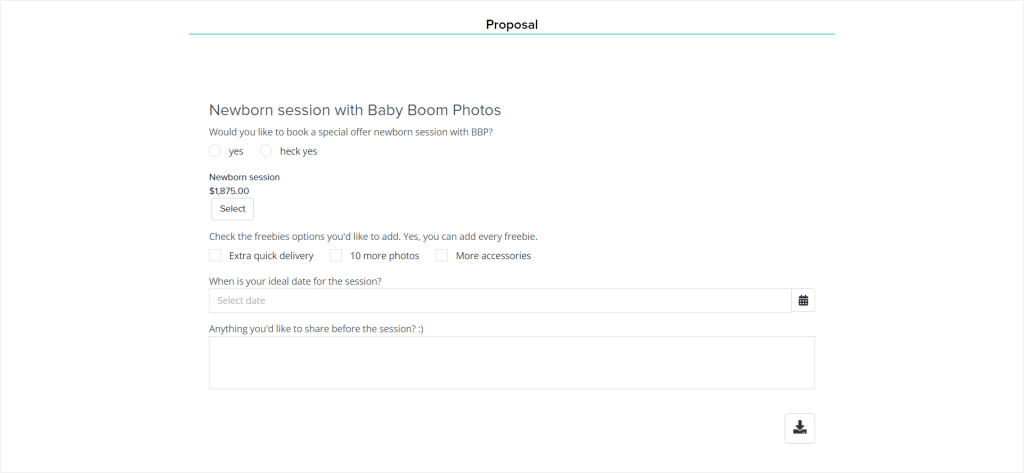
In the case of Tave, there is a main Quotes section but unfortunately, it doesn’t let us create a new quote for the client, it only helps us overview all the quotes we’ve added in the software so far. So to actually share the package with the client, we have to create a new lead or a new job, and from there, head to the Quotes section within it.
Once there, we simply craft the quote and add our premade package. Then, we get two options to share the quote with the client, either through email or via a direct link.
Unfortunately, the end result is not the best. Even though Dubsado is also not an expert in professional modern documents, Tave manages to fall even further behind.
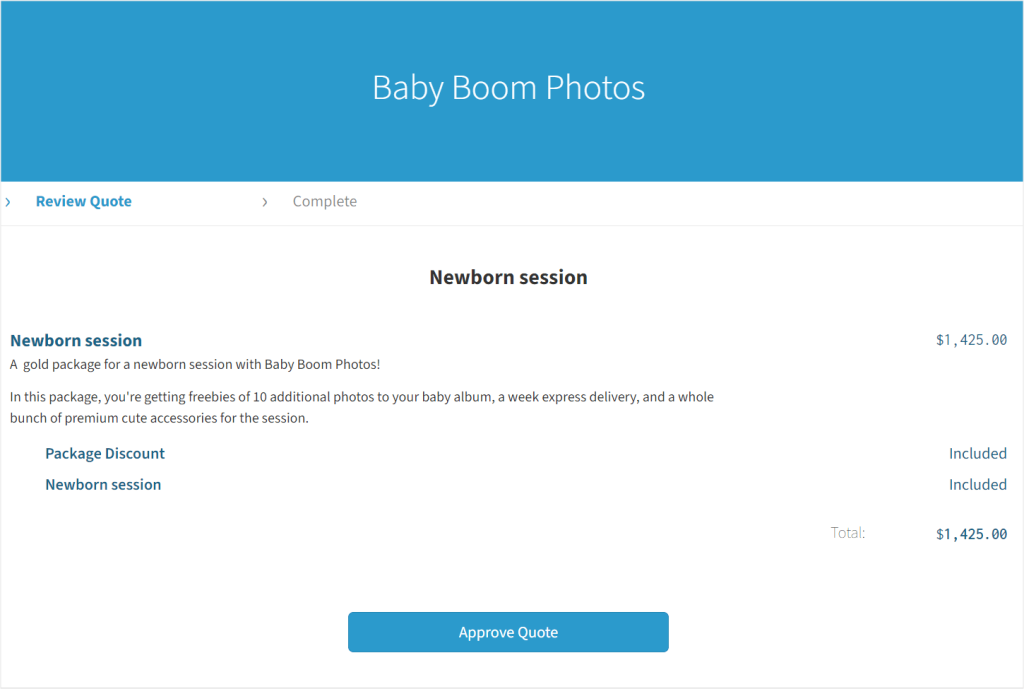
Step Three: Service Delivery
Service delivery in both Tave and Dubsado sort of happens behind the scenes, i.e., outside of the software.
Once your client accepts the quote you’ve shared with them, you can work on delivering the service.
If you need to discuss any further details with your client, you’ll have to use email, either through the software or your own email inbox.
You can of course take advantage of both software’s task management, workflows, invoices, questionnaires, and pipelines to help you better organize your work on the project.
Both tools also have a client portal feature that you can use to share the most important documents pertaining to the project with your clients.
But that’s about it for service delivery capabilities of both the tools in question.
The Surprise Turn: Zendo
You may have been slowly packing your things, ready to choose Tave or Dubsado, but then, a surprise witness enters the court. You can’t help but turn your head to see who that is.
And that someone is Zendo.
If you don’t feel like choosing a little less complicated and outdated tool than another, maybe you don’t have to.
Why Zendo Is A Way Better Choice Than Both Tave And Dubsado?
Zendo is a client portal software that surprises with its non-conventional, yet super efficient solution for service selling, while being modern-looking and easy-to-use. Moreover, it focuses on something most tools seem to forget about — communication.
If you’re wondering if Zendo will be a better choice than Tave or Dubsado, take a look at the benefits it gives you.
Easy to use: Zendo puts intuitiveness and ease of use forefront. This software will definitely not overwhelm you.
Affordable: Zendo is also a great deal for the money you put in. That’s because there’s a completely free Starter plan that in itself is already exhaustive, and an even greater Growth plan for just $19 per user, per month.
Modern-looking: this software is what you need to maintain the professional look with the modern designs and many white label and branding options. Customizing the client portal sign up & log in pages, connecting a custom domain, or removing Zendo’s branding completely? Not a problem with Zendo.
Communication-focused: recognizing the chaos that lack of proper communication brings, Zendo decided to create a solution that combines delivering your services with communication as your source of truth. Its powerful chat allows you to message your clients, chat with your team using internal notes, and combine all of that with the additional chat features, such as quotes, invoices, and payments. That way, you have everything you need for the project stored in one place while being able to resolve any issues with your clients right away.
Supports service selling and productization: selling services solely based on emails and invoices is a system of the past. Zendo gives you the possibility to easily create different types of services, from custom to subscription-based, productize them if you wish, spice them up with add-ons for upselling, and present them on a customizable Service Catalog.
Service delivery overviewed in one place: instead of working behind the scenes and hopping from software to software or section to section, you can overview service delivery in one place — the chat. There, you can follow the progress of each order with in-chat statuses, message your clients and team members, issue quotes, invoices, send out payment requests, make it easy for your clients to complete payments, share files, and more!
Gives your clients what they need: your clients definitely won’t suffer from misinformation. When joining your Zendo workspace, your clients get easy access to all their recent activity, essential documents, shared files, their subscriptions, and chat for communication. They also get a separate space for ordering your services and dedicated dashboards for a quick glance at the important information.
Combines useful features with unique features: This software comes with some unexpected features that ease your processes even further, on top of the obvious functionality. For example, there’s impersonation to take on the role of clients and teammates whenever needed, Zenbot for spicing up automated messages, premium tokens for users on the free forever plan to try out some of the premium features, or its already mentioned chat for effortless & modern communication.
Delivering A Service With Zendo
Remember our fake Baby Boom Photos business? We’re going to use it once more to show you how service delivery goes in Zendo.
Step One: Service Catalog
Unlike Tave and Dubsado, in Zendo you can actually create a separate page that showcases all your services and lets your clients make orders on their own.
The Service Catalog in Zendo is customizable and can include all types of services you add to Zendo, whether productized, custom, mixed, free for general inquiries, or subscriptions.
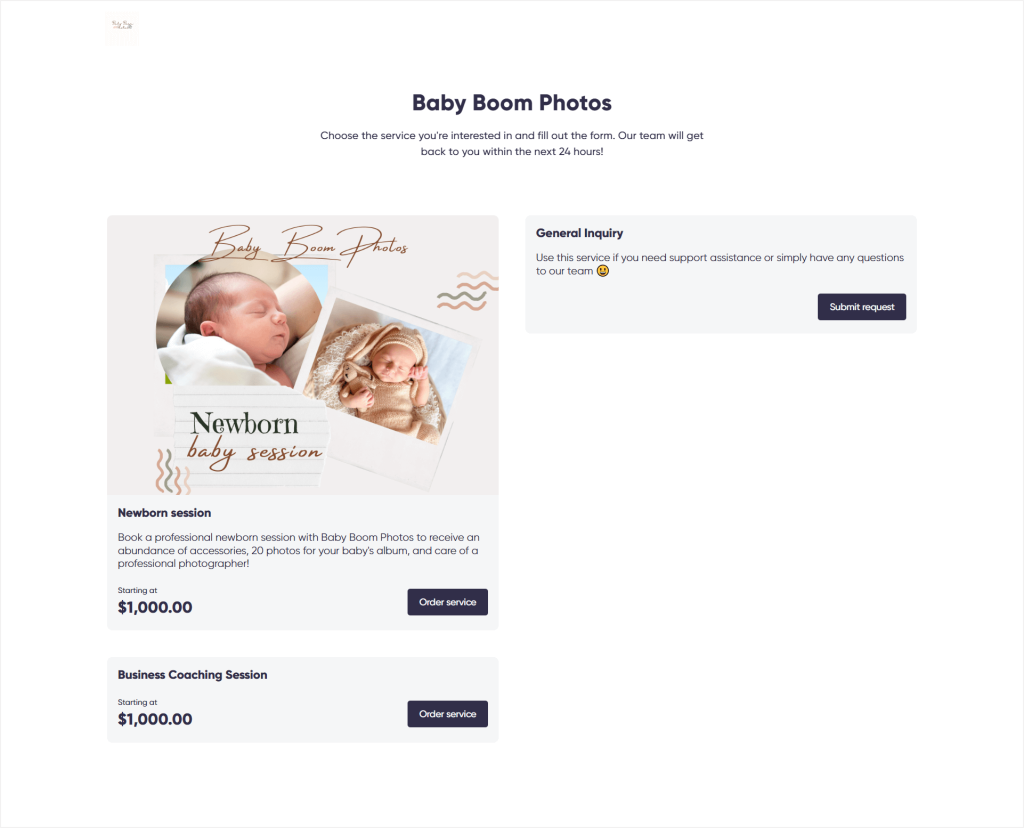
The process of customizing your Service Catalog and adding your services to Zendo is extremely intuitive and the end result does not disappoint. Ensuring a modern and professional feel for you and your clients.
Moreover, you can combine each of your services with a custom-made order form to ensure you’ll have all the details you need for each project, even before you start working on it.
And the fact that your clients can easily visit your Service Catalog anytime and make orders greatly reduces the amount of work you’d normally have to put in to make offers, proposals, or reach out to clients individually via email.
With Zendo, you can forget about creating invoice templates instead of services, adding leads, projects, and jobs, and reaching out with quotes and proposals only to find out that the client doesn’t want to book in the end.
Step Two: Service Delivery
Once your client makes an order, you’ll see a new conversation thread on your main panel that collects all your requests and orders in chat.
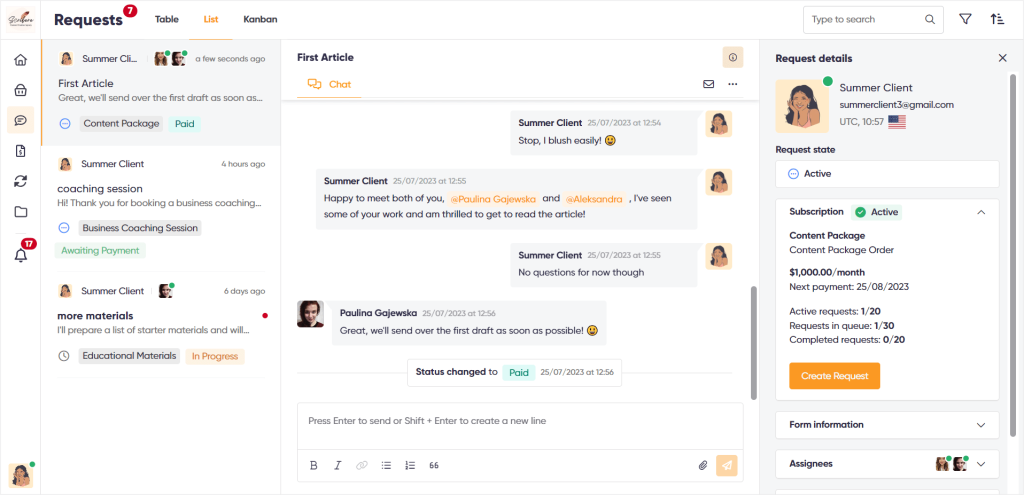
That’s the place you’ll be using to deliver your services, but also talk with your clients and communicate with your team.
The chat combines messages, invoices, quotes, order status, internal team notes, file sharing, and more. Meaning that everything you need to deliver your service, including the space to talk with your customers and discuss any details of the project, happens in one place.
Once you deliver your service in Zendo, your clients can also easily pay for it either using Stripe or a bank transfer. And hopefully, without it being a surprise by now, your clients can actually complete the payments through the already-mentioned chat. If you choose Stripe, your clients will get a direct Pay now button in the chat, while in the case of bank transfers, your clients will get the necessary details for making the bank transfer along with the exact cost in the chat.
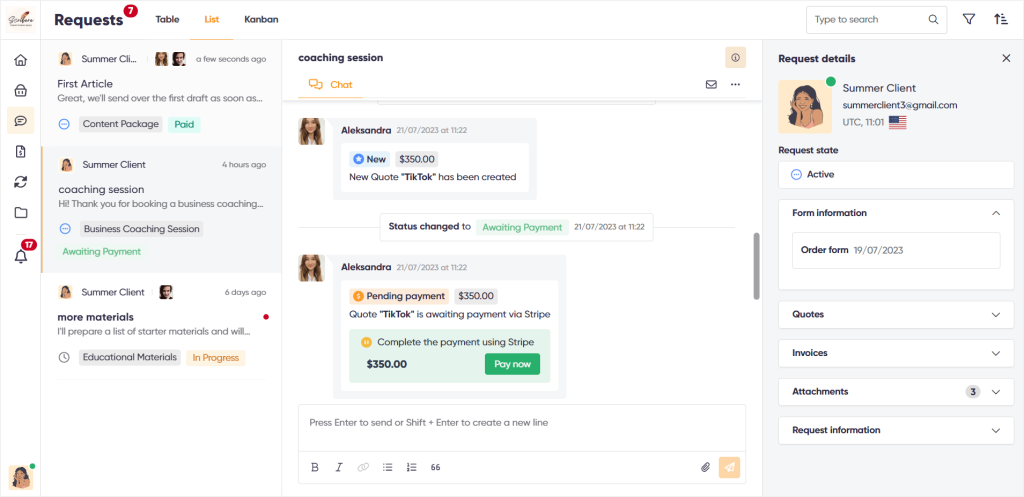
You can follow that up with an invoice and continue the talks with the client should they need any further assistance or a new service delivered, in the same exact spot.
Costs Comparison: Tave Vs Dubsado Vs Zendo
The last matter we want to touch on in this article is, you guessed it, money.
Let’s compare the costs of investing in Tave, Dubsado, and Zendo to really seal the deal, and have everything you need to choose your ideal software.
The following table presents every subscription plan you can find in Dubsado, Tave, and Zendo respectively, with their cost per user, per month, when billed on an annual basis.
| Dubsado | Tave | Zendo | |
| Starter/Solo/Starter | $16.6 | $22.49 | $0 |
| Premier/Boutique/Growth | $33.3 | $31.49 | $19 |
| —/Studio/Enterprise | — | $44.99 | custom |
The Case Of Tave Vs Dubsado: Closing Argument
Beyond reasonable doubt, we find Zendo to be a much better option than both Tave and Dubsado.
To recap why Tave and Dubsado lack a few things, both business management software seem to have lost its connection with the modern times, offering us outdated designs that ultimately lead to an unprofessional look. A good example of that are both software’s client portals that could use a refreshment.
Moreover, both are pretty complicated to operate in, coming with quite a steep learning curve and just too many actions needed in every step we take in the software.
To top it all off, the communication with the client in both tools is based on email, while team communication is non-existent.
Zendo, on the other hand, gives you a simple-to-use software that comes with many useful features for service selling, such as subscriptions, quotes, invoices, Service Catalog, workflows, a chat for communication, and more, while also supporting a professional look.
So if you want to finally have that one place to deliver your services to clients, create your offer and present it like a pro, let clients self-serve in ordering, cut out any misunderstandings from your processes with proper client & team communication, and automate what’s boring — Zendo is the way to go. 👀
For either 0$ a month on the free forever plan or just $19 per user, per month, you can get all that Zendo has to offer!
Create an account to find out how Zendo can help you sell services the easy way, and never look back on complicated software ever again.

A free online training. Delivered daily to your inbox to grow your productized agency.
Frequently Asked Questions: Tave Vs Dubsado
What Is Tave?
Tave is a studio management software that makes it possible for small business owners to capture leads, manage your tasks, issue quotes, invoices, connect a calendar, and more. It’s said to be dedicated to photographers, but its features prove to be useful for business owners from all sorts of industries.
What Is Dubsado?
Dubsado is a Customer Relationship Management software that helps out with project management, workflow automation, client management, document issuing, and more. You can deliver your projects and overview their status following a pipeline, process credit card payments for completed projects, track time on your work, help clients schedule appointments with you, and take a peek at some basic reports created by Dubsado.
Tave Vs Dubsado: Which Tool Is Better?
Both Tave studio management tool and Dubsado combine useful features to help you manage your entire business, from lead tracking to issuing an invoice. But both also come with outdated designs, a steep learning curve, and some unpleasant complexity of use. Choosing one or the other depends on your specific needs. If you don’t crave photography-specific features, Dubsado may be a bit of a better option purely because it’s a bit easier to use and slightly more modern-looking than Tave.
What Is Zendo And Why Is It Better?
Zendo stands among other business software solutions but proves to be unique with its focus on client communication, team collaboration, service selling, and client portal features. It will satisfy all your business needs while remaining easy to use, modern-looking, and affordable!











